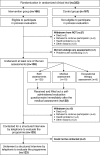Process factors explaining the ineffectiveness of a multidisciplinary fall prevention programme: a process evaluation
- PMID: 18816381
- PMCID: PMC2570681
- DOI: 10.1186/1471-2458-8-332
Process factors explaining the ineffectiveness of a multidisciplinary fall prevention programme: a process evaluation
Abstract
Background: Falls are a major health threat to older community-living people, and initiatives to prevent falls should be a public health priority. We evaluated a Dutch version of a successful British fall prevention programme. Results of this Dutch study showed no effects on falls or daily functioning. In parallel to the effect evaluation, we carried out a detailed process evaluation to assess the feasibility of our multidisciplinary fall prevention programme. The present study reports on the results of this process evaluation.
Methods: Our fall prevention programme comprised a medical and occupational-therapy assessment, resulting in recommendations and/or referrals to other services if indicated. We used self-administered questionnaires, structured telephone interviews, structured recording forms, structured face-to-face interviews and a plenary group discussion to collect data from participants allocated to the intervention group (n = 166) and from all practitioners who performed the assessments (n = 8). The following outcomes were assessed: the extent to which the multidisciplinary fall prevention programme was performed according to protocol, the nature of the recommendations and referrals provided to the participants, participants' self-reported compliance and participants' and practitioners' opinions about the programme.
Results: Both participants and practitioners judged the programme to be feasible. The programme was largely performed according to protocol. The number of referrals and recommendations ensuing from the medical assessment was relatively small. Participants' self-reported compliance as regards contacting their GP to be informed of the recommendations and/or referrals was low to moderate. However, self-reported compliance with such referrals and recommendations was reasonable to good. A large majority of participants reported they had benefited from the programme.
Conclusion: The results of the present study show that the programme was feasible for both practitioners and participants. Main factors that seem to be responsible for the lack of effectiveness are the relatively low number of referrals and recommendations ensuing from the medical assessments and participants' low compliance as regards contacting their GP about the results of the medical assessment. We do not recommend implementing the programme in its present form in regular care.
Trial registration: ISRCTN64716113.
Figures



References
-
- Gillespie LD, Gillespie WJ, Robertson MC, Lamb SE, Cumming RG, Rowe BH. Interventions for preventing falls in elderly people. Cochrane Database Syst Rev. 2003:CD000340. - PubMed
-
- O'Loughlin J, Robitaille Y, Bolvin J-F, Suissa S. Incidence of and risk factors for falls and injurious falls among the community-dwelling elderly. Am J Epidemiol. 1993;137:342–354. - PubMed
Publication types
MeSH terms
Associated data
LinkOut - more resources
Full Text Sources
Medical

